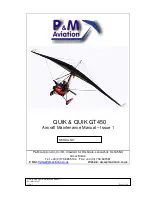
7
If a collapse occurs close to the ground it is essential to react properly. The proper reaction should be taught at high altitude,
ideally under professional guidance (safety training).
If the brake input on the open side is clearly too strong, it can lead to an asymmetric stall (see spin).
Frontal collapse
The front collapse, o en misunderstood as a "front stall", is also a consequence of turbulence. In contrast to the asymmetric side
collapse, the entire leading edge folds down.
The MAESTRO light opens automatically from the frontal collapse, as well as the side collapse independently.
To speed up the reopening, we recommend a slight double-sided braking.
Stall manoeuvres
Spin
A wing rotates negatively when the airflow detaches on one wing half. The canopy turns around the vertical axis with the center of
rotation within the span. The inner wing flies backwards.
There are two causes for spinning:
- a brake line is pulled too far and too fast (for example, when introducing the spiral dive)
- one side is slowed down too much in slow flight (for example during thermal flying)
If an accidentally initiated negative turn is corrected immediately, the MAESTRO light goes into normal flight without any major
loss of altitude. The brake that has been pulled too far should be released until the airflow on the inner wing attaches again.
Attention!
A er a longer negative turn, the paraglider may shoot on one side. This can result in an impulsive collapse or a cravate.
Fullstall
The Fullstall is a complex maneuver whose correct technique can not be fully explained in this manual. Those who want to learn
this maneuver should do so under the supervision of a pilot who masters this maneuver perfectly - the best way during a safety
training.
The available brake travel down to the stall point depends on the wing size! In turbulent air, the stall can occur much earlier or
significantly later. Whoever wants to use the full brake travel, must train many full stalls and get a feeling for the partially or fully
developed stall.
Parachutal stall
The parachutal stall is a flight condition without forward speed and with a significantly higher sink rate. The parachutal stall can
be initiated by the pilot by strong symmetrical braking and is effectively the precursor to a full stall.
The MAESTRO light automatically exits the parachutal stall by fully releasing the brakes.
A very heavily used wing with a porous cloth and / or with an incorrect trim (for example, as a result of many winch starts or deep
spirals) can stay in a stable parachutal stall. This can happen, e.g. when the B-stall is released slowly, or a er a large frontal
collapse.
In addition, the tendency to a parachutal stall is higher with a wet glider or by flying in the rain or in very cold air.
In the case of a stable parachutal stall you should release any brake inputs and push the A-risers forward or pull them down, or -
even better - push the accelerator. A er a slight pendulum movement, the glider returns to normal flight.
In the case of a parachutal stall close to the ground the pilot has to decide whether the altitude is high enough for a pendulum
movement or it is better to prepare himself for a hard landing.
Attention!
When the wing is in a parachutal stall, additional brake input may result in a fullstall!
Summary of Contents for Maestro Light
Page 1: ...1 Manual Version 1 04 of 29 09 2022...
Page 13: ...13 Overview wing...
Page 14: ...14 Lineplan...

























